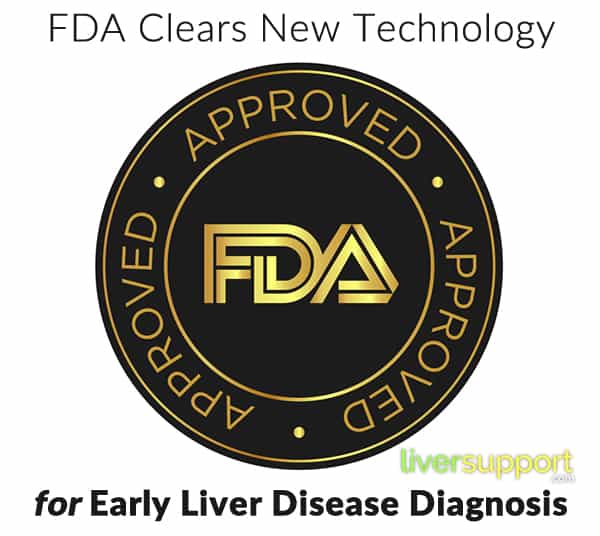
Previous
How Fiber Helps Your Liver

Next
New Therapy for Primary Biliary Cholangitis Patients
FDA Clears New Technology for Early Liver Disease Diagnosis
FDA gives clearance on new tools to reduce the cost of diagnosing liver disease and improve the ability to obtain the diagnosis earlier.
On November 16, 2021, the health technology company Philips revealed that it had received 510(k) clearance from the U.S. Food and Drug Administration (FDA) for new tools it designed to quantitatively measure liver fat. (1) These tools are expected to not only reduce the cost of diagnosing liver disease but also to improve the ability to obtain that diagnosis earlier—before the disease has the opportunity to advance without detection.
How The New Technology Works
Philips explains that its new Liver Fat Quantification tools provide for clearer, more accurate ultrasound images. This improves a practitioner’s ability to determine whether liver disease is present and, if it is, its level of severity (whether it is mild, moderate, or severe).
The company further states that these tools are available for patients with different body types and sizes. Therefore it can be used whether the patient is small in stature or if they have a higher body mass index.
Why This New Technology Is So Important

In the release, Richard G. Barr, MD, PhD, Medical Director of Southwoods Imaging and President of Radiology Consultant, Inc., shared that traditional imaging only indicated whether the liver had a normal or high degree of fat infiltration. This made it difficult to know the stage of the liver disease.
With the new technology, the amount of fat present is noted with a numerical value. This gives a more accurate picture of the levels that currently exist in the liver while also allowing for better tracking of potential increases over time. Since this technology is non-invasive, it can be performed easily and with no recovery time for the patient.
In Liver Disease, Early Diagnosis Is Key
If liver cells contain more than 5% to 10% fat, nonalcoholic fatty liver disease (NAFLD) is diagnosed. (2) Research indicates that NAFLD impacts approximately one in four adults, further stressing that early detection and treatment can help to keep the disease from progressing, sometimes even reversing it. (3)
Early detection is critical because more advanced stages of the disease—referred to as nonalcoholic steatohepatitis (NASH)—increase the risk of needing a liver transplant, also increasing the patient’s risk of death.
What is 510(k) Clearance?
Section 50(k) of the Food, Drug and Cosmetic Act mandates that medical device manufacturers notify the FDA that they intend to introduce a new or significantly modified device to the market in 90 days or so. (4) This gives the FDA time to identify, assess, and properly classify the device.
Obtaining 501(k) clearance also serves another valuable purpose. This process is designed to also ensure that the devices submitted are both safe and effective. (5)
What This Clearance Means for People with Liver Disease
Earlier detection of a liver disease means earlier treatment, and maybe even regression of the disease. The ability to determine the severity helps healthcare providers decide the best course of treatment based on that individual patient’s condition and needs, potentially improving their outcomes.
This is exciting news for people with liver disease, as well as for people with suspected liver disease. It literally provides another tool in the physicians’ toolbox for fighting—and winning—against NAFLD.
(1) Philips. (2021, November 16). Philips Advances Ultrasound Portfolio With New Robust Imaging Tools and Features for Radiology to Increase Diagnostic Confidence and Workflow Efficiency. Retrieved November 18, 2021, from https://www.philips.com/a-w/about/news/archive/standard/news/press/2021/20211116-philips-advances-ultrasound-portfolio-with-new-robust-imaging-tools-and-features-for-radiology-to-increase-diagnostic-confidence-and-workflow-efficiency.html
(2) American Liver Foundation. (n.d.). Nonalcoholic Fatty Liver Disease (NAFLD). Retrieved November 18, 2021, from https://liverfoundation.org/for-patients/about-the-liver/diseases-of-the-liver/non-alcoholic-fatty-liver-disease/
(3) Zhang, J., Cai, J., Yu, Y., She, Z., Li, H. (2019). Nonalcoholic Fatty Liver Disease: An Update on the Diagnosis. Gene Expression: The Journal of Liver Research. doi: 10.3727/105221619X15553433838609
(4) U.S. Food and Drug Administration. (2021, August 31). 510(k) Clearances. Retrieved November 18, 2021, from https://www.fda.gov/medical-devices/device-approvals-denials-and-clearances/510k-clearances
(5) U.S. Food and Drug Administration. (2021, November 15). 501(k) Premarket Notification. Retrieved November 18, 2021, from https://www.accessdata.fda.gov/scripts/cdrh/cfdocs/cfpmn/pmn.cfm






